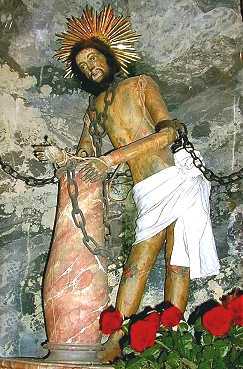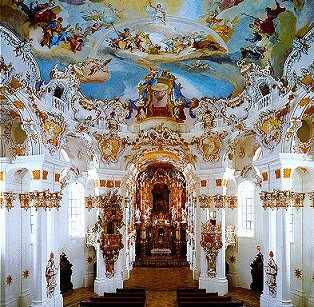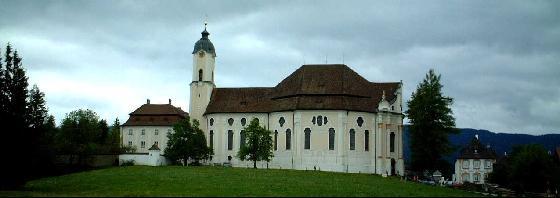

Scourged Saviour statue wept Wieskirche, Germany
 |
 |

|
[Pilgrimage Church of the Scourged Saviour] Wieskirche, Germany
The first time visitors in the Wies, with no previous knowledge about the church, may well stand in wonder and ask themselves what could have possibly given rise to the building of such an unusually magnificent church in such a secluded place. Indeed, something out of the ordinary, from many points of view, took place here. Tears, weeping tears from a Jesus statue, were the spiritual building stones, the precious pearls from which the Wies Church, a world famous roccoco jewel, was created. In the 18th Century the Wies Church was already known throughout Europe as a place of reverence for the Scourged Saviour, and at the same time a famous gem of baroque architecture. Even today the church lives from both these wellsprings: its spiritual and artistic richness. Thus, the Wies Church continues as a pilgrimage church, a place of prayer and worship, and is simultaneously a drawing point for millions of visitors. Through their encounter with this joyous Baroque, full of life and hope, they sense a world which moved the writer Peter Dörfler, in the first half of this century, to write: "The Wies is a bit of heaven in this suffering world." The church honoring the scourged saviour became a place of pilgrimage when a miracle happened on June 14, 1738. There was a statue which was carried in the Steingaden Good Friday processions. This statue of the scourged saviour was originally made in 1730 of wooden parts from other statues; the joints were covered with linen and the entire thing was painted. Very simple. In 1735, this statue was put away in a monastery's attic because the congregation was upset by its pitiful appearance which looked to be covered in blood and wounds. In 1738, the statue was moved to a farmhouse in Wies where tears were seen on the face of the scourged saviour statue. A miracle. At the time the church was just a tiny wooden chapel. People everywhere flocked to see the crying statue. A small church was erected around the statue; they soon decided that it needed to be bigger, hence the Wieskirche. The church was designed around the thought that people needed to repent before God. Once they had repented, life was joyful and happy. The statue represented the repentence of sins, and the bright, colorful, very light church symbolizes the joy after you repent. The Wieskirche stands in the middle of a meadow. Sheep and horses were grazing right up to the church itself. The present church was built in 1745-45 by the brothers Dominikus and Johann Baptist Zimmermann of Wessobrunn. Dominikus could not stand to leave what he considered his most beautiful work and at the age of 70, he built a house almost at the door of church. He lived there until he died. The church was almost sold off and demolished in 1803. Local farmers petitions and prayers were answered in 1811-1830 and the church was saved. The church was completely renovated in 1985-1991 at the cost of 10.6 million. The interior of the church is the light-hearted rococo but still instills a meditative quality. The Abbot and monastery of Steingaden spared no expense in creating this church. The colors red and blue dominate: the red flowing upward signifying the sacrificial blood while the blue from the canopy flows downward, representing God's forgiveness and grace. The choir where the main altar stands is separated from the rest of the church by a railing made of inset wood and on the altar is the statue of the scourged saviour. The painting above the statue is the only work of art not created within the church - it was painted in Munich. On it is the baby Jesus surrounded by his loving family. The child's position with outstretched arms is supposed to a foretell his death on the cross. Above the altar is a golden statue of a pelican. According to legend when the pelican is unable to feed its young, it stabs itself in the chest to allow the young to feed on its blood. The pelican provides another symbol for Jesus who allowed soldiers to spear at his heart so that man might live. The church has windows throughout; they illuminate the inside of the church. The ceilings also contain huge colorful frescoes containing such elements as the resurrected Christ in the middle sitting on a rainbow (sign of forgiveness), angels, the throne of judgement, and the gate to eternity. The frescoes incorporate stucco work; some of the cherubs have a foot protruding from the painting. You begin to lose the line where two and three-dimensionality meet. The ceiling itself is also an illusion of sorts. It appears to be vaulted although it really is almost completely flat with the sides only rising 2.5 meters (not truly vaulted). This is only a tip of the iceberg about the church. One really needs to see it in person to appreciate its splendor.
[Address] - Pilgrimage Church of the Scourged Saviour. Pfarramt Wieskirche, Wies 12, D-86989 Steingaden Germany. |